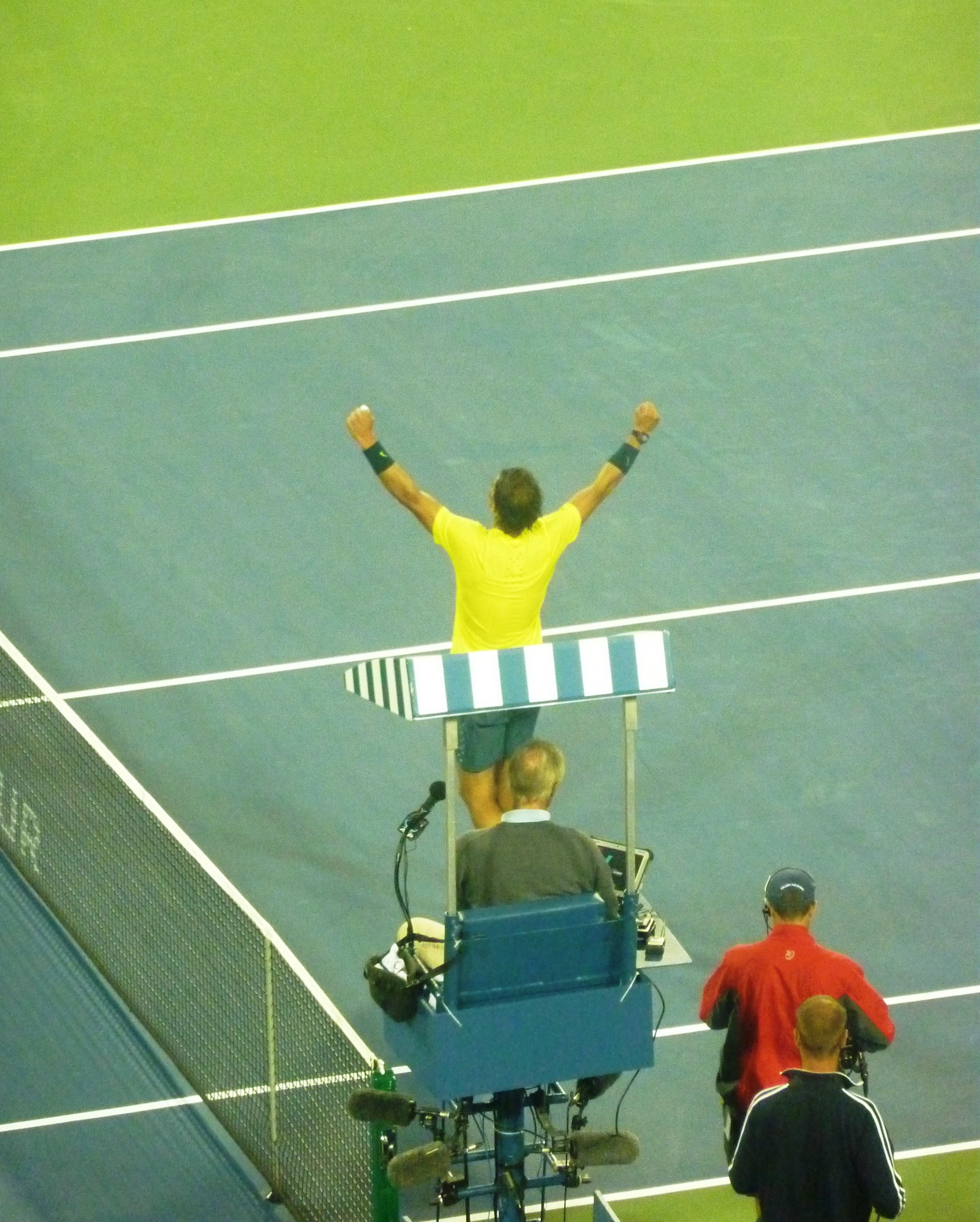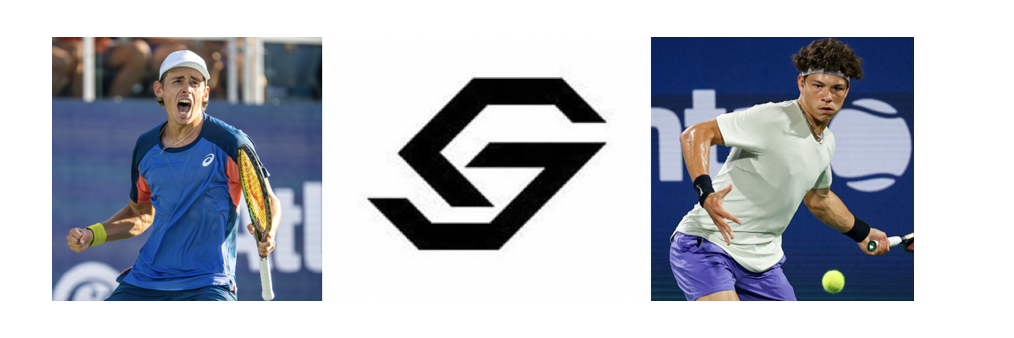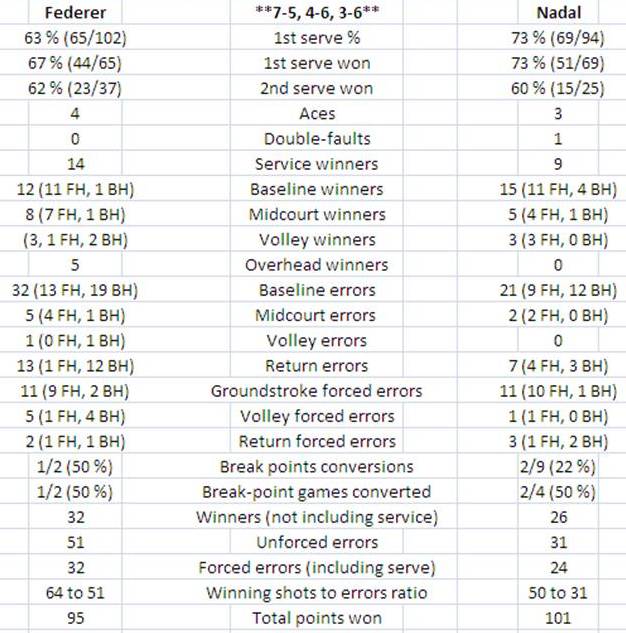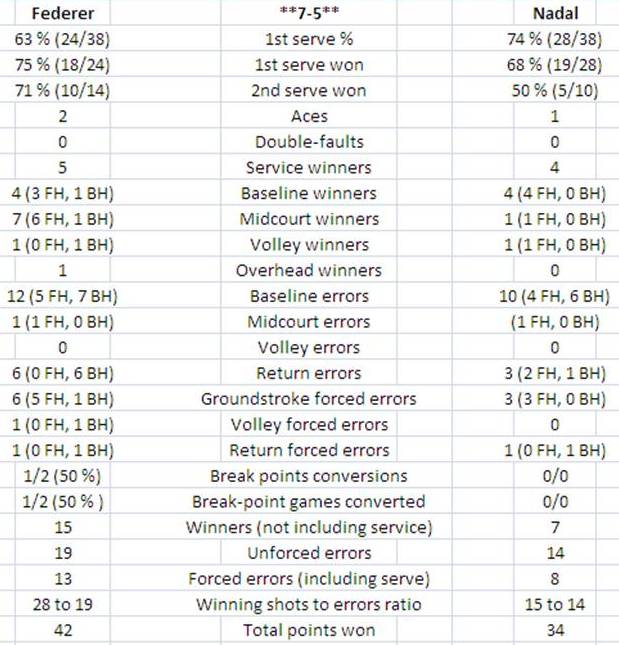
Overall stats:
First-serve percentage did not play a big role for Federer, as he won almost the same percentage of points on first serves as he did on second. The key for Nadal was serving well, because had a much bigger discrepancy of service points won (73 percent on first, 60 on second), and serving well is exactly what he did (73 percent). As usual, Federer was the more aggressive player; he committed 20 more unforced errors than his opponent but also hit 14 more shots that led directly to to winning a point. It is also interesting to note that of the points Federer won, 68 percent came on winning shots (as opposed to Nadal mistakes). Of the points Nadal won, almost exactly half came on winning shots and half came thanks to Federer mistakes.
Set 1:
Federer was clearly the better player in the first set despite the competitive scoreline. He almost doubled Nadal’s total of winning shots (winners + forced errors). The No. 5 seed converted only one break point, but he had break opportunities in two different games. Nadal, of course, did not see a break point in any of his six return games. The Spaniard hit only two outright winners from the middle of the court or at the net. Federer finished nine points in that fashion.
Set 2:
Federer won six points with overheads and/or volleys, but he clearly spent more time behind the baseline without control of points than he did in the first set. After striking seven winners from the middle of the court in the opener, he managed only one such shot in the second. Nadal reduced his unforced error count by six from the first set.
Set 3:
In the first set, Federer hit nine winners from near the service line or inside it. In the second set, he hit seven. In the third set, he did not hit a single winner from the forecourt. In a related statistic, the 17-time Grand Slam champion made 12 backhand errors. Clearly the style of the match had switched completely to Nadal’s favor. Unable to dictate play, Federer could not get anywhere near the net and instead was scrambling back at the baseline and forced to hit backhands. In the deciding set, Nadal hit as many winning shots with his forehand (nine) as he had total unforced errors.






What’s the point of this? Everyone who watched the match knows that Federer was the better player in the 1st set, he won it, didn’t he? Nadal was the better player in the 3rd set and won the important points to win the match. That’s how a tennis match is won and lost, on the important points.
End of.
this one (at least not relative to many other matches) actually DIDN’T boil down to important points.
It boiled down to what, Ricky?
see the stats and the analysis. Fed pushed Rafa all over the place in the first. Less so in the second set, and completely reversed in the third.
Didn’t come down much to big points because Nadal was by far the superior player toward the end of the contest.
So the better player won. What’s there to discuss?
i don’t have anything to discuss. it’s all right there to see.
Ricky, could you start a thread on the USO Draw?
https://tenngrand.com/2013/08/22/u-s-open-draw-discussion/
I like this… where did you find such a detailed statistical analysis from?! well done
i wanted to watch the match again on TV since I was there in person. To get a different perspective. I used a stats app while watching it.
I like this… where did you find such a detailed statistical analysis from?! well done
Not to be contrary, honestly, but I do find the details relevant. In particular as this was one of the rate matches where for the first set and a half at least Roger was doing everything ‘right’ , i.e. using a combination of the most promising tactics, given he was playing Rafa. Rafa kept adjusting and as always also made it hard for Roger (or anyone) to sustain the right kind and high level of play across enough sets.
thats nice, which app is this?? keen to know…
just read tignor’s take on the match and so glad somebody’s take on the amtch is similar to mine lol…he also thinks rafa was off for the first two sets and he picked up the level at 4-4 set 2..from then on it was a dominant show from rafa…. fed’s taking the ball so early had to do with rafa not doing so well early on though…
Even Rafa said as much in his presser.
RAFAEL NADAL: … for me was very difficult to return his serve. I didn’t find the right position on court to return the ball. He was really winning all the games on his serve very, very easy.
Finally, I found a solution.
Q. Rafa, how do you think that you turned that match around? At what point, and what adjustments were you able to make?
RAFAEL NADAL: I think my movement starts to be better, more intensity. I started to put more balls inside on the return, and I started to have more times control of the ball from the baseline with my forehand, something that didn’t happen the first set and a half.
Q. You said it took about a set and a half to get the moves down to actually start returning the serve better. At that point, do you think the caliber of his serve dipped a little bit, or was it mostly you making those adjustments?
RAFAEL NADAL: No, I think it was more because I did things better than because his serve goes down, no? I didn’t had that feeling.
#GOAT
I agree with chloro and vamosrafa. I like seeing this kind of detailed statistical analysis. I always come away with my own personal sense of how the match went, but it doesn’t hurt to see this kind of analysis. You can see how the key stats changed as Rafa started to play better in the latter half of the second stage and then took that momentum into the third set.
I thought this match started off as a continuation of his match with Dimitrov. I thought that was probably Rafa’s weakest performance at Cincy. I thought he let that second set get away from him and then had to play a third set.
I think Rafa was returning serve much better later in the second set and in the third set. That was one of the keys for him. In that third set the stats clearly showed Rafa taking control of the match.
Rafa explained what happened in the match vs G. Dimitrov – he was defensive in the 2nd set and made adjustments in the beginning of the 3rd set.
—R. NADAL/G. Dimitrov 6‑2, 5-7, 6‑2
THE MODERATOR: Questions, please.
Q. Rafael, it looked like a straight‑set win. You were in control in the second set and then let him back in the match. Can you go over that period of the match, please.
RAFAEL NADAL: Yes, I was playing right the first set. I played a good level in the first set. Then his serve was working well in the beginning of the second. I was having trouble, so just wait for my moment.
That moment happened, so I had the break, 40‑15, and then I played a few bad games in a row so I lost the set.
Positive thing, I was ready to accept that situation, accept that I played a few bad games. I played more defensive than what I was doing the last couple of weeks.
And from behind, the shots here are not the same than from inside the baseline, so I started the third set trying to go another time inside the court and trying to have the control of the point from there, and I think I played a good third set in general.—
Vamos Rafa the adjustment-maker!
Thanks Ricky! I like this form of detailed analysis, I really do. The guys at changeovertennis.com do something similar but it is always nice to get a different perspective or read of the stats, so hope you make this a regular feature Ricky, especially for the important/interesting matches.
What I would ask you to do though Ricky please is give a summary (I know you included one) which gives YOUR view of what Rafa did right to win the match for example. In your summary you say “In the deciding set, Nadal hit as many winning shots with his forehand (nine) as he had total unforced errors.” but I can read that from the stats sheet! What I would like to know is what adjustment, in your opinion, did Rafa make to be able to hit those winners with his forehand that he was unable to in the 1st and 2nd set.
Thanks Ricky!
ritb,
I think Ricky did say what he thought in his little summary after posting the stats for the third set. He said that Fed didn’t hit a single winner from the forecourt in the third set. He also pointed out that Fed hit 12 backhand UE’s. He said that Fed was unable to dictate play and had to hit backhands from the baseline. That won’t work against Rafa, because of his forehand. All the winners Rafa hit with the forehand and Fed making UE’s with his backhand showed that Rafa was able to turn it around and go the pattern that has worked for him in the past.
i mean i could go into it more but the stats are rather self-explanatory